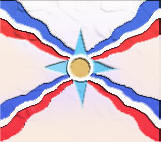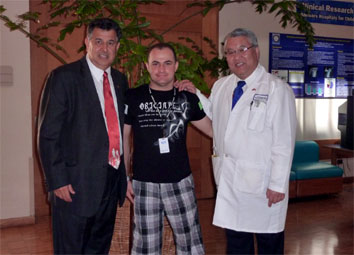

Out of The Ruins of “Dur Sharukin” Comes a Shrine

zowaa - Helen talia
In the Alchemist, Paulo Coelho writes that when we dream, the whole universe aligns itself to help us realize that which we dream. He speaks of Personal Legends, our calling in life, and that in meditation, we do in fact find that the world has a soul, and that the soul is found in every facet of life ~ face, plant, animal. They all have souls that are transmitted into physical forms that we encounter in our personal experiences. Some we take with us for the rest of our journey in this embodiment, while others are just lessons that we either learn from, or go back to the lesson once again.
I sat across from Salma Younan as she tearfully told me the story of how her son ended up in a wheelchair. Samer Butrus was eleven years old in 2003 when he was caught by a land mine that blew off his left leg and shattered his right one, while volunteering to help secure water in his village, Kremlish.
Out of the ruins of “Dur Sharukin” from the reign of “King Sargon” in the ancient Assyrian village of Kremlish, located in the heart of the Nineveh Plain, (Meshtakha D’Nineveh, Assyrian,) Samer came to us after undergoing an emergency surgery in Iraq which left him with above the left knee amputation and open fasciotomy wounds on the right leg, in addition to the damaged sensory nerve of the remaining right leg.
In Iraq, he had no chance of walking due to the lack of sensation in the remaining leg. He was offered another amputation that would have made it extremely difficult to walk, even if the proper prosthesis were to be found.
Back in the States, where Shriners Hospitals for Children – Los Angeles has become a “Shrine” for almost every Assyrian child that has visited the United States for medical treatments, the Assyrian Medical Society, through the intercession of its Chairman Albert Davidoo, who is also the Vice-Chairman at Shriners, was able to petition for Samer to undergo the necessary procedures, where he was accepted and has been for nearly one year.
The procedure, thus far, has been to save the right leg so that he can walk in it and use it as a natural crutch for the left leg prosthesis. He has also undergone nerve transplantation of the right leg three months ago. Just weeks ago, it was time to fit him in prosthesis for the right leg and for the first time since 2003, he is now able to walk and is finally free of his wheelchair.
Like most things in life, essentially everything has a way of working itself out. Samer, too, has made full circle with his recovery, as best as his limitations have allowed him to, without turning back. But finding cure for patients is more than just healing their physical challenges. It is giving hope to the desolated, far beyond what the war has taken away from them. It is the strengthening of the soul to connect to the fiber of humanity, oftentimes rendered by brokenness to the point of humility, which in turn births the capacity to serve mankind without any reservations or exceptions. After all, what good is it if in the process of healing the body, the soul is left without nurturing? In the end, what we each need the most is to heal those parts that are broken in us.
For Samer, despite physical limitations there is a far greater proof that the accident back in 2003 was not, but an intersection, because what God wants to do on the earth, He will do through intercessors. Today, despite the daunting ordeal that halted Samer’s volunteerism, God has placed upon the heart of Albert, who himself has become a “Shrine” of hope upon whose heart God has placed His desires. After all, Albert’s own intercession was not quite an accident either.
Throughout their journey together, these two men have bonded so much that they have perfected the “dance” of giving and receiving. Albert has exemplified the art of breeding a new generation of a philanthropist, demonstrated advocacy, and above all, instilled characteristics of a good human being in Samer. This is how succession happens, when the notion to serve humanity prevails above all else.
A good soul deserves a good body to live in ~ Still resolved to save those around him, Samer’s perseverance to salvage his ability to walk again is a testimony of will and a strength of character, qualities that distinguish survivors from victims. In summary, Samer has refused to be labeled by victimization.
In conclusion, I challenge my readers to answer the following question: How have you impacted another person’s life after having left a mark on it?
The Assyrian Medical Society would like to thank the following selfless volunteers who assisted with the completion of Samer’s medical mission ~ Dr. Srood Maqdasy, Mr. Salim Kako, the Assyrian Democratic Movement ~ Iraq.
Mr. Salim Alyawer (Abu Umar), United States Embassy ~ Jordan.
Wilson and Helen Nicolai, Romel Neesan (2008 Volunteer of the year), Ramina and Edward Sardarbikian and family, David and Nineveh Lazar, John Jacob and family, Yousif Jacob, Joan Mansour and family, Ashur Giwargis, His Holiness Mar Emmanuel of Mar Shallita Church ~ Holy Catholic and Apostolic Church of The East, Gilbert Yousefpour, St. George Egyptian Church and St. Mary Assyrian Church of the East, Baba Adram, Ben Michael Fard, Ashur and Nanet Aghasi, Emil Rostamo, Charlie Pirayoo, Dr. Lorence Esho, Dr. Abdul Aziz, Dr. Youil Mamook, Mr.. Youkie Khaninia, Zabo & Maggie, Nahrain Lazar, Nina Klyana, Marcos Marcos and many more ~ United States.
Dedicated to the loving memory of the late Archbishop Mar Paulos Faraj Rahho who bestowed the honor of “The Hero of Kremlish”upon Samer ~ “True love is not loving a person that is complete, but completely loving a person that is incomplete.”
|
|
|||
|
|
|
|
|
|
|
|||
|
|
|||
|
|
|||
|
|
|||
|
|
|||
|
|
|||
|
|
|||
|
|
|||
|
|
|||
|
|
|||
|
|
|||
|
|
|||
|
|
|||
|
|
|
||
|
|
|||